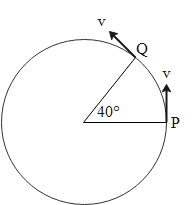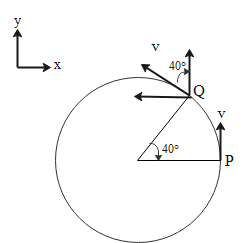
A particle is moving in a circle of radius r with a constant speed v. The change in velocity in moving from P to Q is

$
{\text{A}}{\text{. 2v cos 20}}^\circ \\
{\text{B}}{\text{. 2v sin 20}}^\circ \\
{\text{C}}{\text{. 2v cos 40}}^\circ \\
{\text{D}}{\text{. 2v sin 40}}^\circ \\
$

Answer
584.1k+ views
Hint: If we consider the particle to be moving in an x-y plane, then we can resolve the components of the velocity along the x-axis and y axis. Change in velocity is equal to difference between velocity at Q and the velocity at P.
Detailed step by step answer:
We are given a particle which is moving in a circle of radius r with a constant speed v. The diagram shows two points of the trajectory of the particle.

If we consider the particle is moving in a x-y plane then at point P, the expression for velocity can be written as follows since it's pointing towards the y-axis.
$\overrightarrow {{V_P}} = V\widehat j$
For point Q, we must write the velocity vector in terms of its components as follows:
$\overrightarrow {{V_Q}} = - V\sin 40^\circ \widehat i + V\cos 40^\circ \widehat j$
Here the angle at Q has been calculated using the fact that a tangent to a circle subtends a right angle with the radius of the circle.
Now the change in velocity from P to Q can be given as
$
\overrightarrow {\Delta V} = \overrightarrow {{V_Q}} - \overrightarrow {{V_P}} \\
= - V\sin 40^\circ \widehat i + \left( {V\cos 40^\circ - V} \right)\widehat j \\
= - V\sin 40^\circ \widehat i + V\left( {\cos 40^\circ - 1} \right)\widehat j \\
$
Now we need to calculate the magnitude of this change in velocity which will give us the required answer.
$
\Delta V = |\overrightarrow {\Delta V} | = \sqrt {{{\left( { - V\sin 40^\circ } \right)}^2} + {{\left\{ {V\left( {\cos 40^\circ - 1} \right)} \right\}}^2}} \\
= V\sqrt {{{\sin }^2}40^\circ + {{\left( {\cos 40^\circ - 1} \right)}^2}} \\
= V\sqrt {{{\sin }^2}40^\circ + {{\cos }^2}40^\circ + 1 - 2\cos 40^\circ } \\
$
Using the identity: ${\sin ^2}\theta + {\cos ^2}\theta = 1$
$
\Delta V = V\sqrt {2 - 2\cos 40^\circ } \\
= V\sqrt {2\left( {1 - \cos 40^\circ } \right)} \\
$
Using the identity: $1 - \cos \theta = {\sin ^2}\dfrac{\theta }{2}$
$
\Delta V = V\sqrt {4{{\sin }^2}20^\circ } \\
= 2V\sin 20^\circ \\
$
This is the required change in velocity; hence, the correct answer is option B.
Note: It is mentioned that the particle is moving with constant speed. It means that the magnitude of velocity is constant but when a particle moves in a circular orbit, its speed may remain constant but the direction of velocity changes at every point of the path. Velocity changes as it is a vector quantity and it is dependent on the direction of the vector.
Detailed step by step answer:
We are given a particle which is moving in a circle of radius r with a constant speed v. The diagram shows two points of the trajectory of the particle.

If we consider the particle is moving in a x-y plane then at point P, the expression for velocity can be written as follows since it's pointing towards the y-axis.
$\overrightarrow {{V_P}} = V\widehat j$
For point Q, we must write the velocity vector in terms of its components as follows:
$\overrightarrow {{V_Q}} = - V\sin 40^\circ \widehat i + V\cos 40^\circ \widehat j$
Here the angle at Q has been calculated using the fact that a tangent to a circle subtends a right angle with the radius of the circle.
Now the change in velocity from P to Q can be given as
$
\overrightarrow {\Delta V} = \overrightarrow {{V_Q}} - \overrightarrow {{V_P}} \\
= - V\sin 40^\circ \widehat i + \left( {V\cos 40^\circ - V} \right)\widehat j \\
= - V\sin 40^\circ \widehat i + V\left( {\cos 40^\circ - 1} \right)\widehat j \\
$
Now we need to calculate the magnitude of this change in velocity which will give us the required answer.
$
\Delta V = |\overrightarrow {\Delta V} | = \sqrt {{{\left( { - V\sin 40^\circ } \right)}^2} + {{\left\{ {V\left( {\cos 40^\circ - 1} \right)} \right\}}^2}} \\
= V\sqrt {{{\sin }^2}40^\circ + {{\left( {\cos 40^\circ - 1} \right)}^2}} \\
= V\sqrt {{{\sin }^2}40^\circ + {{\cos }^2}40^\circ + 1 - 2\cos 40^\circ } \\
$
Using the identity: ${\sin ^2}\theta + {\cos ^2}\theta = 1$
$
\Delta V = V\sqrt {2 - 2\cos 40^\circ } \\
= V\sqrt {2\left( {1 - \cos 40^\circ } \right)} \\
$
Using the identity: $1 - \cos \theta = {\sin ^2}\dfrac{\theta }{2}$
$
\Delta V = V\sqrt {4{{\sin }^2}20^\circ } \\
= 2V\sin 20^\circ \\
$
This is the required change in velocity; hence, the correct answer is option B.
Note: It is mentioned that the particle is moving with constant speed. It means that the magnitude of velocity is constant but when a particle moves in a circular orbit, its speed may remain constant but the direction of velocity changes at every point of the path. Velocity changes as it is a vector quantity and it is dependent on the direction of the vector.
Recently Updated Pages
Master Class 12 Business Studies: Engaging Questions & Answers for Success

Master Class 12 Economics: Engaging Questions & Answers for Success

Master Class 12 English: Engaging Questions & Answers for Success

Master Class 12 Maths: Engaging Questions & Answers for Success

Master Class 12 Social Science: Engaging Questions & Answers for Success

Master Class 12 Chemistry: Engaging Questions & Answers for Success

Trending doubts
What is meant by exothermic and endothermic reactions class 11 chemistry CBSE

Which animal has three hearts class 11 biology CBSE

10 examples of friction in our daily life

One Metric ton is equal to kg A 10000 B 1000 C 100 class 11 physics CBSE

1 Quintal is equal to a 110 kg b 10 kg c 100kg d 1000 class 11 physics CBSE

Difference Between Prokaryotic Cells and Eukaryotic Cells




